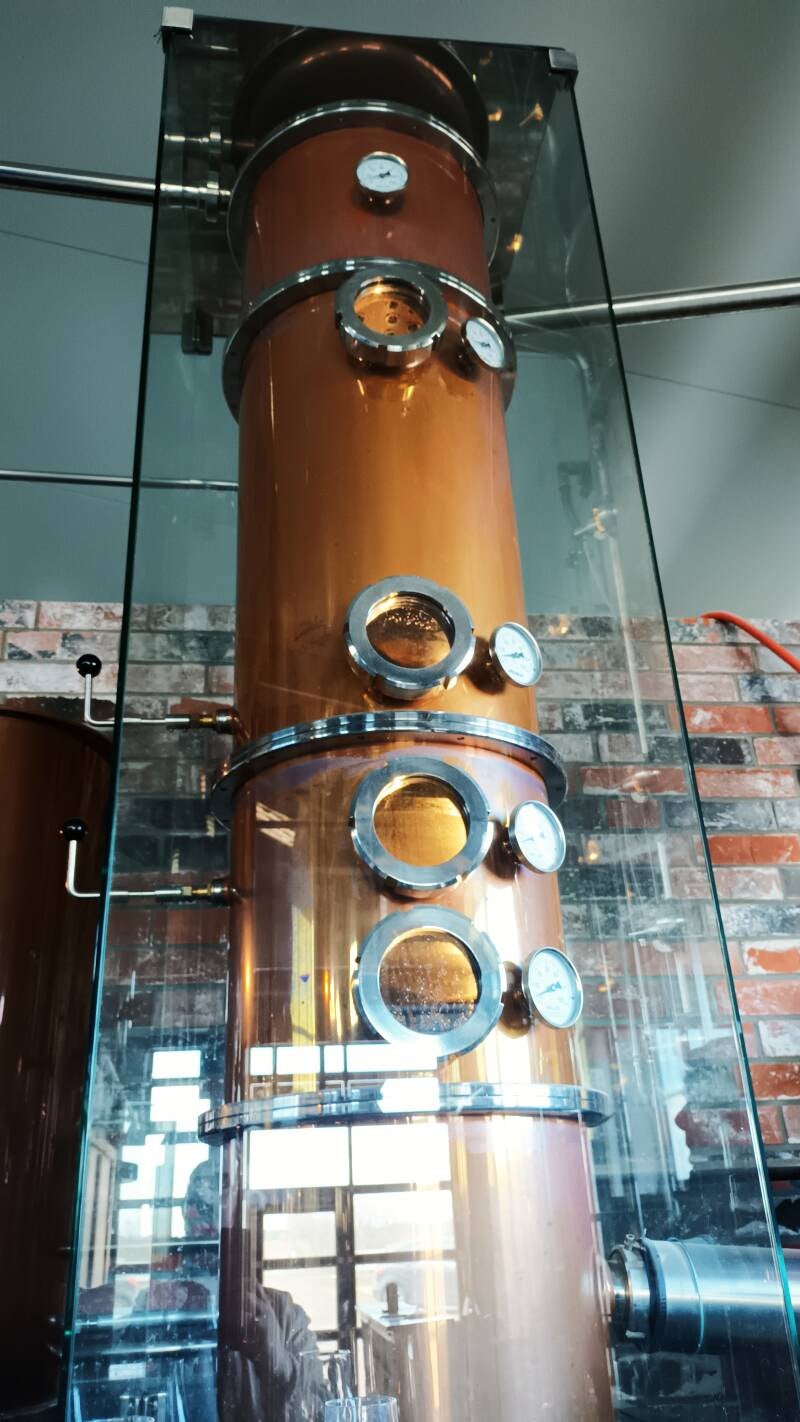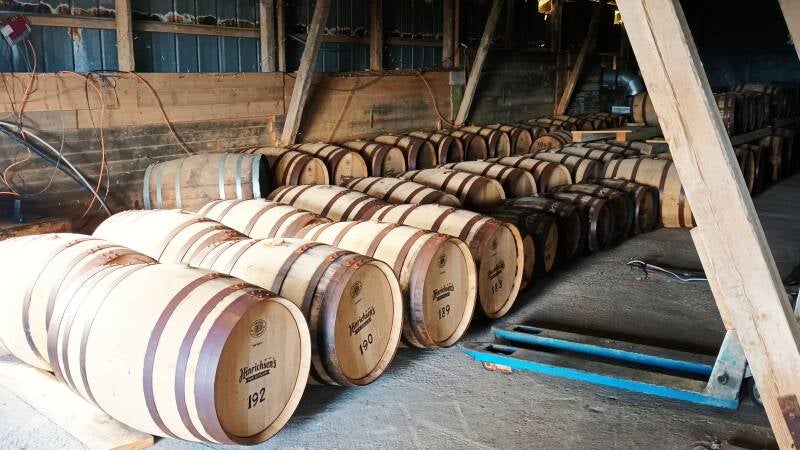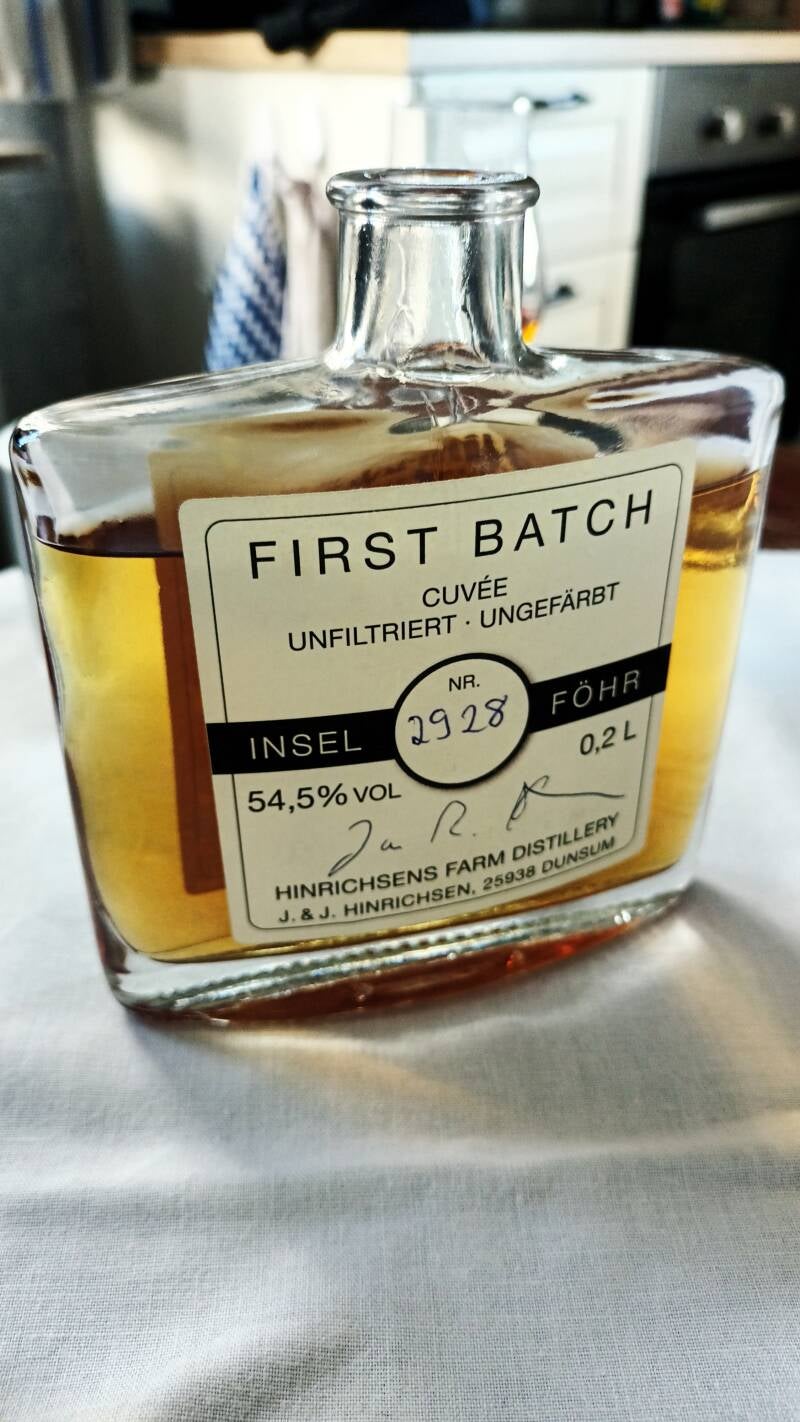A Single Farm, Single Malt, Island Whisky
(DE-HRS, no.499)
This is a distillery visit for the more adventurous! After a morning of train travel from Denmark and a ferry to the island of Föhr, I met Jan, the owner and distiller at Hinrichsens Farm which claims to be the only true farm distillery in Germany.
Right up front, it's worth saying that Jan is very helpful and enthusiastic about his whiskey and island of Föhr itself. One of the North Frisian islands, Föhr is almost as far north in Germany as you can go - save for its larger and more famous holiday-destination cousin, Sylt.


Family operated, the Hinrichsens farm lies on the western side of Föhr, only a few hundred meters from a sea wall facing the winds of the North Sea. The whole distilling operation takes place inside a historic barn. The family are building a new entrance, and renovating the ground floor.
Alongside a cafe-bar space, they have the stills and malt-drying areas, while the roof and former hayrick hold barrels of maturing whisky. By the way, the family's café includes burgers made from the farm's own meat. Jan tells me that soon this will include more dry-aged and whiskey-aged meats…
While the distilling operation is only a few years old here, the Hinrichsens farm dates back to the 17th century. In the 19th century, the family included whalers who went to the USA by way of Holland. Some became lumberjacks, others bar workers in Florida… and one had a deli in the Bronx, whose shop logo was preserved and turned into the logo for Hinrichsens whisky. I love that!
Enough about the history - what about the whiskey being made here?

BARLEY & MALTING
Jan explained how all the barley used for this Frisian single malt is grown right here on the farm. They've been growing organic grain for seven years now, with pigs and oxen getting the draff. To highlight this, Jan labels his whiskey both as a single malt and as a 'single farm' whisky. I think it's quite a helpful category, and there are certainly a handful of other distilleries across Europe who might want to describe their drams this way.
One surprise I hadn't expected was Jan's malting floor. Not only is the whiskey here made from the farm's own barley, but Hinrichsens malts their own barley too. If you're not familiar, only a handful of Scottish distilleries do any of their own malting any more, and most of those (eg, Laphroaig, Highland Park, Balvenie) also rely on malt from other sources to meet demand. Springbank is the only exception.

Made custom by Danish mechanics, the Hinrichsens malting floor works similar to Stauning and Thy's custom malting floors in Denmark. However, this one had to be installed in a barn roof - and it fits exactly within the barn's old timber frame.
Jan has developed a very detailed understanding of malting - it's probably the most complex thing he has to handle in order to create his whisky. Malting in a barn roof, he finds the seasons changing the speed and timing of the process. In the summer, a fan allows malting to keep going up to outside temperatures of 21C: above that, the germinating malt overheats. Likewise, a heater can get malting started in the winter. Once the process gets going, the malt generates its own heat.


DISTILLATION
With their current equipment, Hinrichsens can only do 1 sparge (between 65 and 72C), which leaves a lot of sugar behind in the draff. The pigs might enjoy it, but it's not very efficient or economical. Currently, they can make 840L of wort which ferments for 5 days. They end up with 50L of whiskey - when Jan shows me the dried malt area, he explains that everything I can see will only make enough to fill 2 barrels.
Hinrichsen's distilling process is very different from the straight double distillation I had seen the previous day at Trolden and Fary Lochan. It's a single hybrid distillation, maybe most comparable to Penderyn's Faraday still . While it produces spirit closer to 72% than Penderyn's 92%, this still has a column with copper plates, a pipe allowing reflux to lead back into the still, and a coil that all the vapor has to escape through: a kind of pre- condenser copper worm.
When Jan sent off samples to Müller for analysis, they likened it to something which had been run through a pot still 4 times. Of course, if you tried that in reality, you would end up with a very expensive process producing a completely neutered spirit. Thankfully, Hinrichsens does not strip all the flavor from its distillate at all - it simply benefits from really extended copper contact.

AGING
Back to the barn, it's a great space… but with winter temperatures still around, it was freezing! Jan uses barrels from the Rodriguez cooperage in Malaga, mostly 60L in size as they can't afford to wait much more than 3 years for their whiskey to age! You do get a significant shift in heat across seasons in the open, airy barn roof - slightly resembling the American rickhouses that helped inspire Jan on a trip to Ohio.
Feeling very lucky, I took a glass that Jan had just drawn straight from a bourbon hogshead. I swirled the glass and saw pieces of char drift in the liquid. With the cask strength estimated at 62-63%, and only just brushing 3YO, this dram already had a lovely set of fruit aromas and a surprisingly subtle finish. Strangely, it was more fruity than the PX sample I also got to try - that one was oily, with green apple notes. That said, me and Jan had to warm the ice cold glasses firmly with our hands to get any aromas out of them.
Finally, Jan drew a sample from a Jack Daniels cask. He had got a handful of these in as an homage to his grandfather, who was apparently a big J.D. fan. This was probably my favourite dram of the three. Lemony, tangy, but with a malt depth still present. It really benefited from being cask strength, and reminded me of Teaninch, if you want a comparison to Scotch whisky.


TERROIR/ORIGINS
While on the farm, I talked to Jan about the idea of terroir in his whisky. It's easy to focus on the still, or the malting floor, or the local source of barley, but Jan stresses that every step makes a difference. When you have to do every process yourself making a 'single farm' distillery, you make choices at every stage which determine the whisky's character. No single step is 'the' step to creating a signature whisky.
While this whiskey is very young at present, there are already hints of this terroir developing. Given the salt spray blowing over the barley and the whole distillery, you get a saltiness in the new make which must be the terroir.
Think about where Hinrichsens comes from too. It may be a whiskey made in Germany, but the bottle says 'Frisian' for a reason, and it seems to have one foot in Denmark. Hinrichsens have good links to Danish distillers Ærø and Thy. Not only are these family businesses focusing on organic production in rural areas, but their geographical surroundings and founding ideals are similar. The owners all know each other well, and they all use similar Müller-made hybrid stills.
While everyone is inspired by Scottish distillers, none of these producers are directly replicating Scotch whisky. As Jan says about Hinrichsens, 'We are Frisian - we don't want to make Scotch.' He describes how the area's concept of Selbstvertrauen - self-confidence - informs this idea. 'Independence is a very important word for me.'
This all takes place in the context of Hinrichsens being very much a family business. With 130 acres of grazing and barley-growing space, Jan's farm is still vulnerable to market fluctuations. It's the same tough position farmers everywhere experience; everyone has to diversify. Whiskey-making is one way to provide stability for the farm's economy, and Jan hopes to create an environment where his children can stay.

That's one link to Scotland, in any case - children from rural areas having to emigrate for work. It's a problem that much of the world could set to music. So far, Jan's efforts seem to thankfully be paying off. His daughter works in marketing and tours for the distillery; his son chose to work on the farm, and was busy at work fitting a new floor downstairs when I visited.
Hinrichsens has already attracted some international attention. This includes recent visits by Bill Owens, a whiskey writer and founder of the American Distilling Institute , and Julia Nourney, a German blender and independent spirits consultant with over 20 years of experience.
In turn, Jan has also recently visited Arbikie, Lindores, Glengoyne, and Nc'nean in Scotland for some research of his own. Speaking of Nc'nean, Jan cites them as inspiration for his efforts to make Hinrichsens a fully renewable-powered distillery. Currently, they get about 30% of their power from solar panels and use a wood-chip heater for water: the goal is to install a windmill in the near future.
Their goal is to sell 2,500 liters next year - about 4,000 more are waiting to hit the 3YO mark. Bear in mind that Hinrichsens' production capacity is currently 8000 LPA - *assuming the barley harvest goes well*. Relying on their own barley, there's no insurance against variable harvests, or economies of scale. Production is going to vary - but hopefully the development of the distillery and upgrades such as a new washback will help them make better use of what they grow.
THE FIRST BATCH
That's enough detail - what about Hinrichsen's first release? What is their 'First Batch' like?
Jan's first whiskey is a blend of bourbon, PX, and oloroso casks. It's chewy, spicy, without the sherry being too heavy. The American oak sweetness is there… I struggled to place it more exactly until Jan suggested marzipan as a tasting note.
This dram has an amazing toasty nose and freshness. Jan also suggested coffee as an aroma, and while that normally makes you think of dark espresso aromas, if you imagine a light filter coffee then that description really does fit.
And this is 3 years old! You'd never believe it.


This ended up being a real deep dive into this small, family-run distillery - but I hope you agree that Hinrichsens is worth it! This whiskey would be so easy to miss when looking at the map of Europe , or even just Denmark and Germany. If Hinrichsens stays on its current trajectory, this farm distillery will become an absolute gem of the North Frisian islands and a fantastic rare dram. If you can spare the travel time, go see it for yourself… just, maybe wait for warmer weather first!


Add comment
Comments